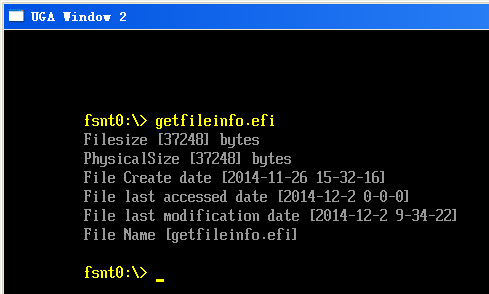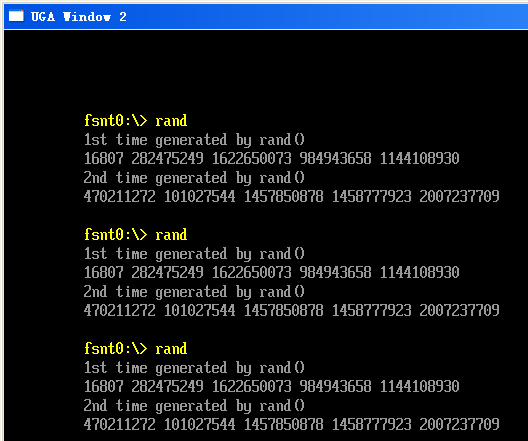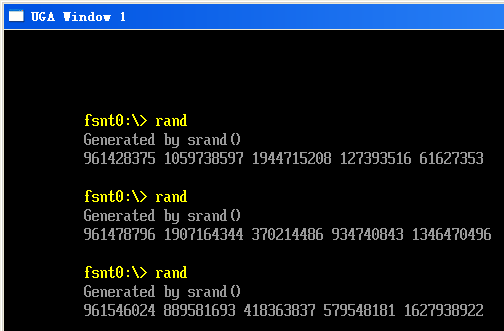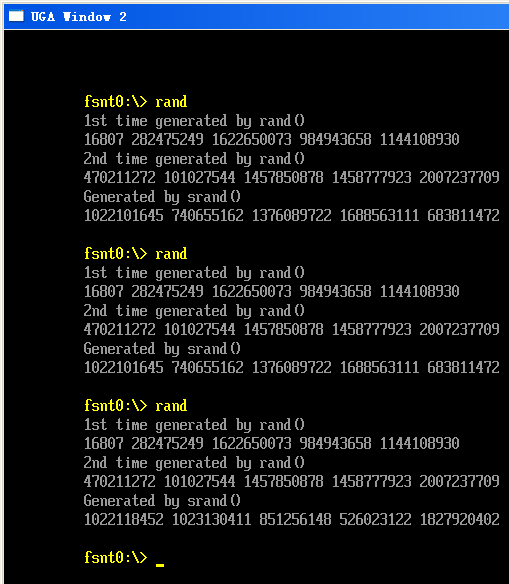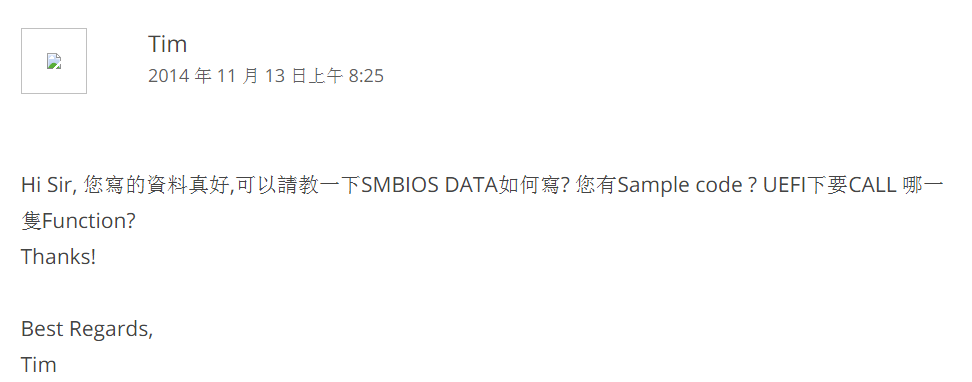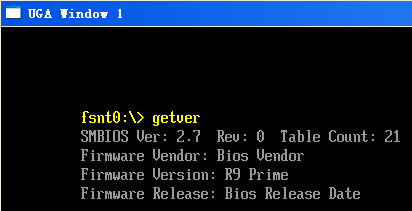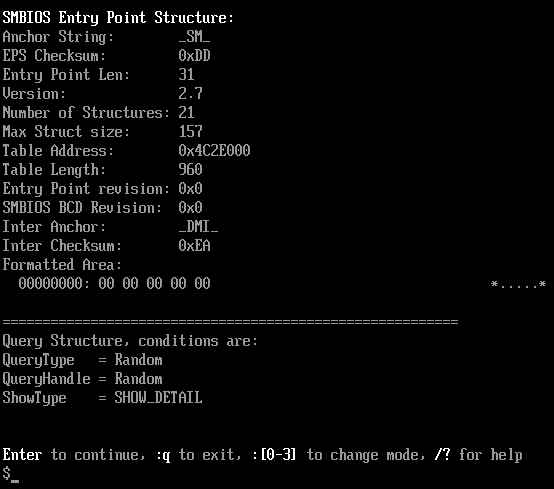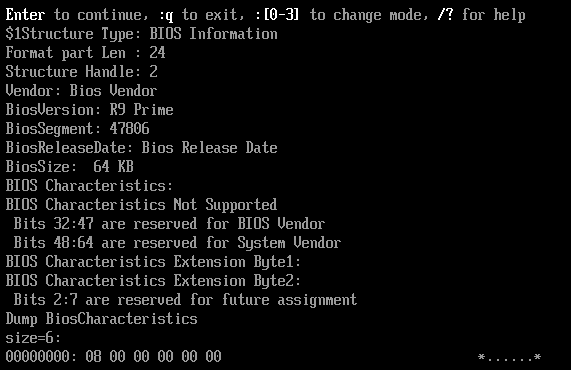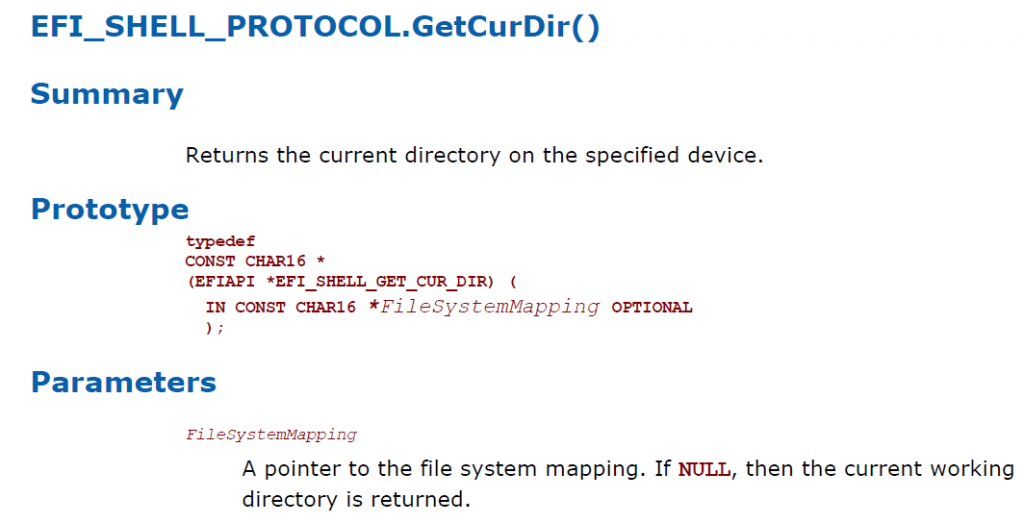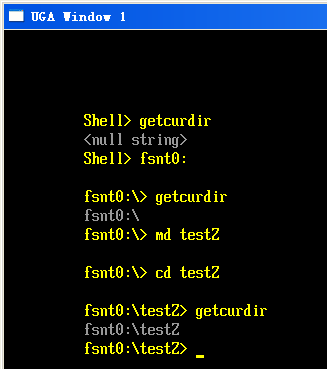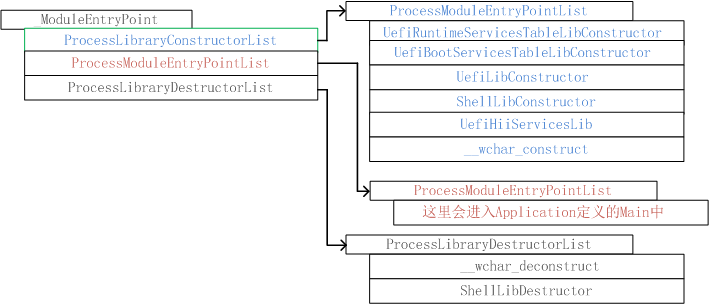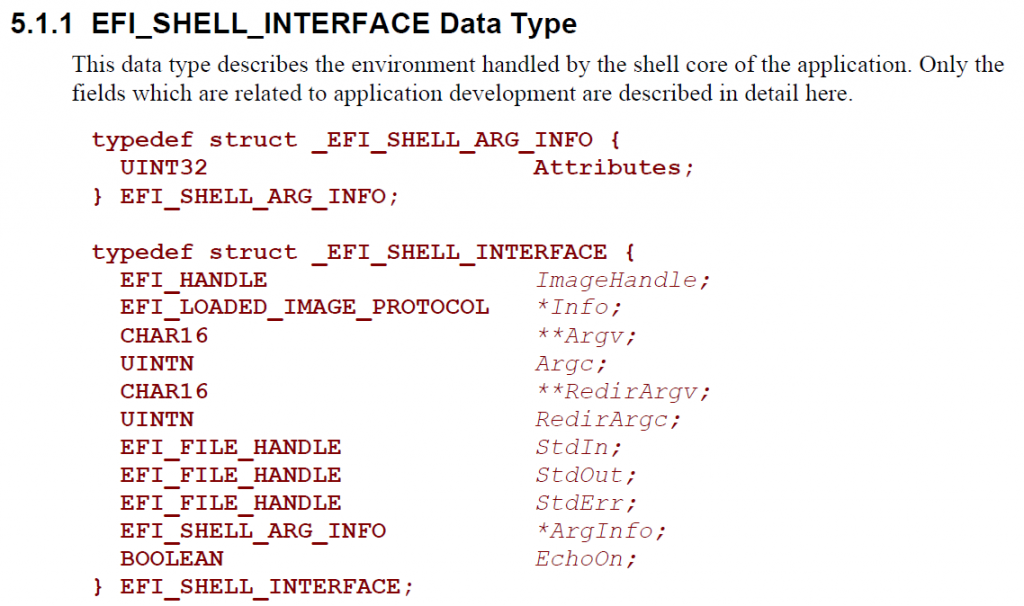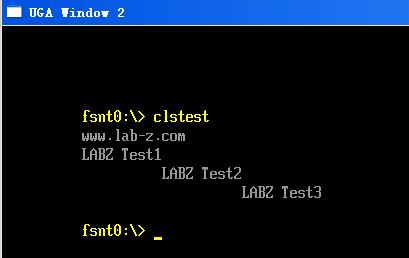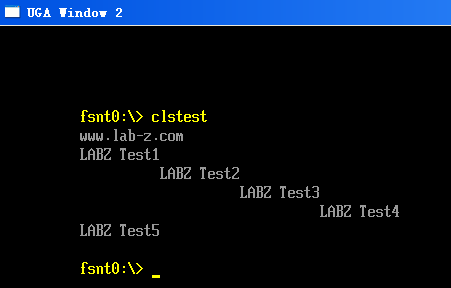这里介绍一个能够获得文件基本信息的函数: GetFileInfo
可以在 \ShellPkg\Include\Library\ShellLib.h 看到定义
/**
This function will retrieve the information about the file for the handle
specified and store it in allocated pool memory.
This function allocates a buffer to store the file's information. It is the
caller's responsibility to free the buffer.
@param[in] FileHandle The file handle of the file for which information is
being requested.
@retval NULL Information could not be retrieved.
@return The information about the file.
**/
EFI_FILE_INFO*
EFIAPI
ShellGetFileInfo (
IN SHELL_FILE_HANDLE FileHandle
);
需要FileHandle作为输入函数,输出结果是 EFI_FILE_INFO 结构体。 这个结构体可以在
\MdePkg\Include\Guid\FileInfo.h 这个文件中看到(同时在 \EdkCompatibilityPkg\Foundation\Efi\Protocol\FileInfo\FileInfo.h 里面也有一个定义,只是这个定义未参加编译)。需要注意,调用的函数负责给结果分配一块内存,你自己的程序要负责释放这块内存的。
typedef struct {
///
/// The size of the EFI_FILE_INFO structure, including the Null-terminated FileName string.
///
UINT64 Size;
///
/// The size of the file in bytes.
///
UINT64 FileSize;
///
/// PhysicalSize The amount of physical space the file consumes on the file system volume.
///
UINT64 PhysicalSize;
///
/// The time the file was created.
///
EFI_TIME CreateTime;
///
/// The time when the file was last accessed.
///
EFI_TIME LastAccessTime;
///
/// The time when the file's contents were last modified.
///
EFI_TIME ModificationTime;
///
/// The attribute bits for the file.
///
UINT64 Attribute;
///
/// The Null-terminated name of the file.
///
CHAR16 FileName[1];
} EFI_FILE_INFO;
看这个结构体可以得知,我们能够获得文件的大小,创建时间,修改时间属性文件名等等。
对于时间的定义 EFI_TIME 可以在 \BaseTools\Source\C\Include\Common\UefiBaseTypes.h 看到。相比之前我们看过的 time_t ,这个结构体是很单纯的定义,不需要换算:
// EFI Time Abstraction:
// Year: 2000 - 20XX
// Month: 1 - 12
// Day: 1 - 31
// Hour: 0 - 23
// Minute: 0 - 59
// Second: 0 - 59
// Nanosecond: 0 - 999,999,999
// TimeZone: -1440 to 1440 or 2047
//
typedef struct {
UINT16 Year;
UINT8 Month;
UINT8 Day;
UINT8 Hour;
UINT8 Minute;
UINT8 Second;
UINT8 Pad1;
UINT32 Nanosecond;
INT16 TimeZone;
UINT8 Daylight;
UINT8 Pad2;
} EFI_TIME;
对于 Attribute 的定义,在 \MdePkg\Include\Protocol\SimpleFileSystem.h
// // File attributes // #define EFI_FILE_READ_ONLY 0x0000000000000001ULL #define EFI_FILE_HIDDEN 0x0000000000000002ULL #define EFI_FILE_SYSTEM 0x0000000000000004ULL #define EFI_FILE_RESERVED 0x0000000000000008ULL #define EFI_FILE_DIRECTORY 0x0000000000000010ULL #define EFI_FILE_ARCHIVE 0x0000000000000020ULL #define EFI_FILE_VALID_ATTR 0x0000000000000037ULL
最后,写一个程序验证一下
#include <Uefi.h>
#include <Library/UefiLib.h>
#include <Library/ShellCEntryLib.h>
#include <stdio.h>
#include <stdlib.h>
#include <wchar.h>
#include <Protocol/EfiShell.h>
#include <Library/ShellLib.h>
extern EFI_BOOT_SERVICES *gBS;
extern EFI_SYSTEM_TABLE *gST;
extern EFI_RUNTIME_SERVICES *gRT;
extern EFI_SHELL_PROTOCOL *gEfiShellProtocol;
int
EFIAPI
main (
IN int Argc,
IN char **Argv
)
{
EFI_FILE_HANDLE FileHandle;
RETURN_STATUS Status;
EFI_FILE_INFO *FileInfo = NULL;
Status = ShellOpenFileByName(L"fsnt0:", (SHELL_FILE_HANDLE *)&FileHandle,
EFI_FILE_MODE_READ , 0);
if(Status != RETURN_SUCCESS) {
Print(L"OpenFile failed!\n");
return EFI_SUCCESS;
}
FileInfo = ShellGetFileInfo( (SHELL_FILE_HANDLE)FileHandle);
Print(L"Filesize [%ld] bytes\n",FileInfo-> FileSize);
Print(L"PhysicalSize [%ld] bytes\n",FileInfo-> PhysicalSize);
Print(L"File Create date [%d-%d-%d %d-%d-%d]\n",
FileInfo-> CreateTime.Year,
FileInfo-> CreateTime.Month,
FileInfo-> CreateTime.Day,
FileInfo-> CreateTime.Hour,
FileInfo-> CreateTime.Minute,
FileInfo-> CreateTime.Second);
Print(L"File last accessed date [%d-%d-%d %d-%d-%d]\n",
FileInfo-> LastAccessTime.Year,
FileInfo-> LastAccessTime.Month,
FileInfo-> LastAccessTime.Day,
FileInfo-> LastAccessTime.Hour,
FileInfo-> LastAccessTime.Minute,
FileInfo-> LastAccessTime.Second);
Print(L"File last modification date [%d-%d-%d %d-%d-%d]\n",
FileInfo-> ModificationTime.Year,
FileInfo-> ModificationTime.Month,
FileInfo-> ModificationTime.Day,
FileInfo-> ModificationTime.Hour,
FileInfo-> ModificationTime.Minute,
FileInfo-> ModificationTime.Second);
Print(L"File Name [%s]\n",&FileInfo->FileName[0]);
free(FileInfo); // Free up the buffer from ShellGetFileInfo()
return EFI_SUCCESS;
}
代码下载:
GetFileInfo
参考:
1.本文的例子参考 \ShellPkg\Library\UefiShellLevel3CommandsLib\Touch.c
